PASS IT ON volume thirteen
Sidetracks & Detours: Weekend Walkabout
PASS IT ON volume 13
August 13th 2023
Welcome to Sidetracks and Detours Weekend Walkabout: PASS IT ON volume thirteen. We bring you listings of Live Jazz From Reading from Jim Wade and of Jazz On Air from Steve Bewick´s Hot Biscuits show. We can also tell you the English Folk Exposition (EFE) is still very busy preparing for not only this year´s folk festival but also next years too. We bring you news of all that and of the latest folk-chart climbers too. EFE have also introduced us to Folk On Foot who seem to a great bunch of music-loving, like minded people. So come, let us introduce you. Meanwhile, Steve Cooke, delivers more excellent reviews from all across the arts, before our reporter Ralph Dent raises a glass when one of the world´s finest music-journalist proposes a toast to the old Jazz Piano. Another of our regular writers, Peter Pearson looks at all points forward before Norman Warwick takes a confused and confusing look at a one m,an show by John Malkovich on Lanzarote that was an actor´s autobiography of an autobiography of a German serial killer, with lots of literary theory, classical music from a live tirty piece orchestra, and operatic sopranos singing and playing as Malkovich played games with genre and gender to have his audience dizzy, but delighted, by the end . So, take a Detour, to where there´s plenty to read.

CONTENTS
folk music
FOLK FESTIVAL AND CHART DETAILS
from English Folk Expo
FOLK ON FOOT´
presented by Folk On Foot
all across the arts
NEWS, PREVIEWS, INTERVIEWS, REVIEWS
from Steve Cooke
Jazz On Air
HOT BISCUITS BY Steve Bewick
Recorded Jazz Music
as Geoffrey Himes proposes a toast to JAZZ PIANO
Ralph Dent raises a glass
A Reader´s Perspective
ALL POINTS FORWARD by Peter Pearson
Island Insights
a unique musical production
at Jameos Del Agua, Lanzarote, July 2023
featuring actor John Malkovich
THE INFERNAL COMEDY
review by Norman Warwick


folk festival and chart details
from English Folk Expo
photo This month, we add Katey Brooks to the Manchester Folk Festival line up. Katey is a rebellious artist who resists being pigeon-holed, with a sound blending folk, soul, blues and Americana. Support for the multi-award winning eclectic folk and Americana singer-songwriter Lady Nade, this is not a gig to be missed
LOW TICKET WARNING
photo John Smith is a celebrated guitarist and songwriter, renowned for his transatlantic blend of fingerstyle and slide guitar.
He is supported by Clara Mann whose motive alt-folk ballads capture the restlessness of youth and the power of optimism.
photo Unthanks Known for their genre-blurring creativity, The Unthanks premiere their dream-like winter fantasia, embracing both the dark and the light in the most ritualistic of seasons, moving in and out of focus, like a memory, a hymnal to our shared winter experience. Echoes of winter tunes known throughout the western world, mix with the traditional and the newly written, all passed with great care and love through The Unthanks filter
As the UK waits for summer to start, the July Official Folk Albums Chart 2023 is already here. Produced by English Folk Expo in partnership with The Official Chart Company, July’s chart sees a new number 1, plus five other new entries.
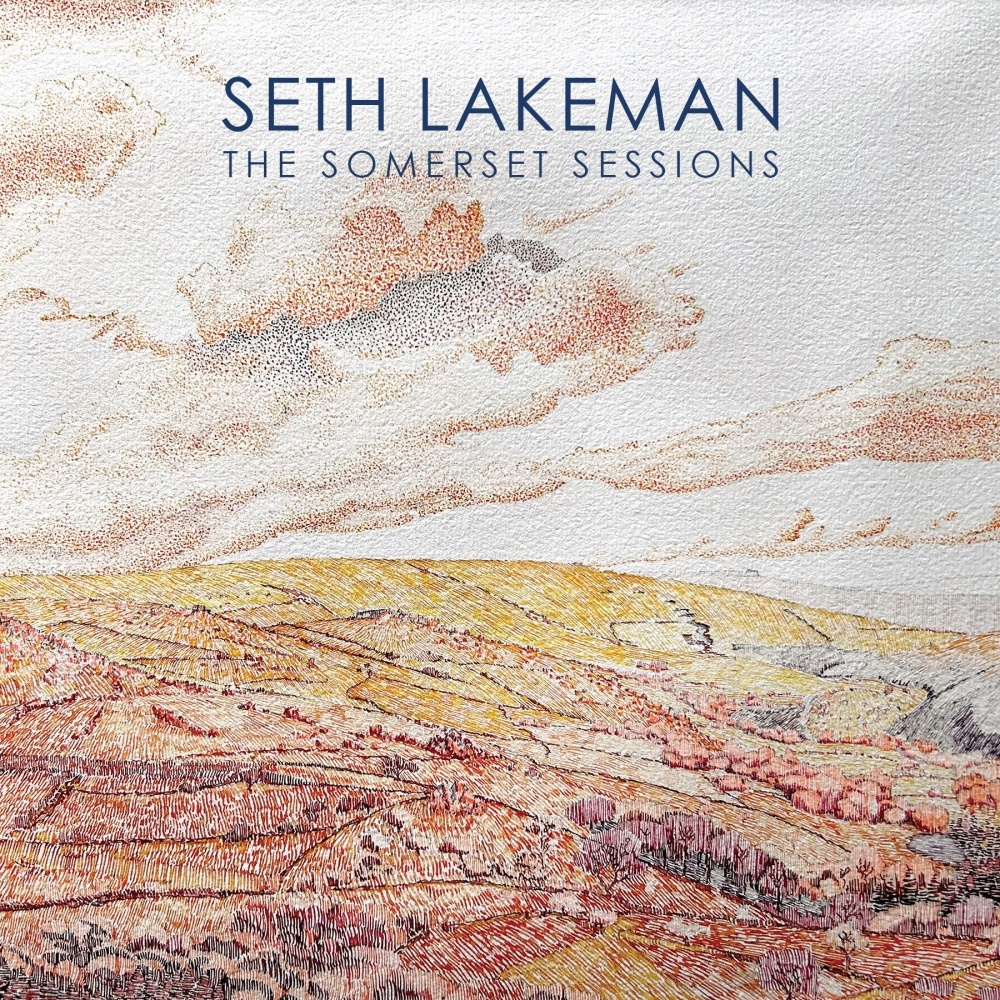
‘The Somerset Sessions’ (Honour Oak) (left) is straight in at number 1.The general release of a limited-edition vinyl released earlier this year for Record Store Day, the album was recorded over ten days late in 2020 at the Bert Jansch Studio in Frome. It features Lakeman fronting a band comprising drummer Ethan Johns, keyboard player Jeremy Stacey, John Smith on guitar and bouzouki, bassist Nick Pini and a co-vocal with singer Alex Hart on the closing song. The Arts Desk describes it as, ‘A lean set of 10 high-quality songs replete with memorable hooks and choruses’.
New at 3 is ‘Dance Till All The Stars Come Down’ (Poetica) from The Lilac Time, the country-folk band, originally formed in 1986, by Stephen Duffy and brother Nick, now with Nick’s wife Claire, and here joined by multi-instumentalist Ben Peeler. Folk Radio UK says, ‘It’s magnificent; it will make your heart dance until the stars come down’.
The other top ten entry this month is Brigid Mae Power’s ‘Dream From The Deep Well’ (Fire) at number 10.The fourth album from this Irish singer-songwriter and multi-instrumentalist achieved four stars in Uncut which suggested it was her, ‘most resolute yet’. Recorded to tape, the Irish Times says, ‘This is vital, intelligent and dreamy music: alchemical brilliance.’
Recorded in his home studio in Brighton and arriving on the chart at number 24, Jacko Hooper’s ‘Respair’ (Folklore) traces the journey from his mental health crisis during the pandemic with openness and honesty. Reviews have praised this release from the increasingly important Folklore label. Clash says it is, ‘something quite darkly beautiful’.
In at 28 is ‘C’Sides’ (The Longest Johns)by the Bristol-based shanty and The Longest Johns, best known for their part in the ‘Wellerman’ TikTok viral phenomenon. Band member JD describes it as, ‘a collection of demos and unreleased oddities’. It includes several livestream favourites and some songs for which the band had released YouTube videos previously, but which had not yet made it onto an album.
The final new entry for July, in at 30, is ‘Striding Out’ (Brown Boots)by fiddle and melodeon duo Will Allen and Martin Clarke, otherwise known as Brown Boots. The follow up to their 2020 ‘First Steps’ album, Bright Young Folk says of this latest album,’This is music infused with authenticity and passion, two ingredients that Brown Boots splendidly combine as they move from jigs to reels, from hornpipes to Cotswold Morris tunes.’
To view the full Official Folk Albums Chart chart click here. To watch to Official Folk Chart Show again, click here or the image below
.
The Official Folk Albums Chart is compiled by The Official Chart Company and produced by English Folk Expo. The Official Folk Albums Chart Show is presented by Folk On Foot with the support of English Folk Expo.

English Folk Expo(Charity no 1192064)is a sector support organisation and a National Portfolio Organisation funded by Arts Council England. It has a growing portfolio of initiatives designed to support the English folk, roots and acoustic sector including its annual English Folk Expo Showcase for UK and international industry, showcasing a broad range of English folk, roots and acoustic artists in Manchester, England each October. To find out more go toenglishfolkexpo.com

Folk On Foot
presented by FOLK ON FOOT
Folk on Foot was launched by the broadcaster and former BBC executive Matthew Bannister in August 2018, bringing together his three passions: folk music, walking and telling stories in sound.
n each episode Matthew walks with a leading folk artist in the landscape that has inspired their music and they sing and play on location. The list of artists taking part reads like a Who’s Who of the contemporary folk scene.
The locations are often spectacular, ranging from mountain tops to remote white sand beaches and from a disused brick factory on the outskirts of Sheffield to a Sussex wood in the middle of the night. We also hear the sounds of the natural world: curlews circling overhead, waves crashing on the shore, campfires crackling and rivers burbling under bridges.

MATHEW BANNISTER: Host (left)
In a media career lasting over forty years, I’ve been a senior BBC executive, launching BBC GLR in the 1980s, re-positioning Radio 1 and becoming Director of Radio in the 1990s and ending my management career as Chief Executive of Production and then Director of Marketing and Communication. I’ve also been a broadcaster, starting out on BBC Radio Nottingham, London’s Capital Radio and Radio 1 Newsbeat and more recently presenting shows on Radio 5Live, the BBC World Service and Radio 4 where I still host the weekly obituary programme Last Word. But Folk on Foot is my own personal project and reflects my three life-long passions: folk music, which I have loved since I was a teenage fiddle player in a band touring the clubs around Sheffield; walking, which again started in my youth, when I first explored the Peak District with my family; and telling stories in sound which has given me the greatest pleasure throughout my working life. In short, after all this time, I have finally created my perfect job

NATALIE STEEL:Producer
I make audio for broadcast and beyond; usually about emotions, ideas and the arts. Recent work for Radio 4 includes A Short History of Solitude and Green Originals. Podcasts include The Sound of Anger (British Podcast Award 2020 Gold x2) and Voices of British Ballet. When I’m not bindweed wrangling and broad bean conjuring in my allotment, I walk whenever I can.

photo OWEN RALPH: Digital Marketing Manager
I’m an arts marketer and digital content producer, with a particular passion for developing new audiences for independent folk musicians. Few initiatives in recent years have done that as successfully as Folk On Foot, which makes it an incredibly exciting project to work on. Aside from my work on Folk On Foot, I created the ‘How to Do Digital’ video series for English Folk Expo’s Folk Talk initiative, helping musicians to optimise their digital channels. I also have my own occasional podcast Future-Proof Folk, exploring initiatives which keep the folk scene thriving, and make music with my ‘Chamber Folk’ project and my duo, Abi and Owen. Being from the Welsh valleys, I love setting off for a walk with a camera through the nearest mountain range, or making do with nearest hill when in disappointingly flat London

photo LUCY SHIELDS:Researcher / Marketing Manager
I grew up surrounded by folk music, and it’s always been one of my biggest passions, so it seems inevitable that it’s ended up becoming my career! After starting out working in publishing and digital marketing, I moved into the world of music a few years ago with a role in the marketing team at Sage Gateshead. When the pandemic came along, I started a lockdown newsletter called The Folk Forecast and began picking up freelance work, eventually taking the plunge as a full-time freelance Arts Marketer. Along with Folk on Foot, I also work with organisations including Live to Your Living Room and Soundpost, as well as being an Agent at Fancourt Music. When I’m not busy booking or promoting gigs, I enjoy getting out to explore the many cultural gems in the North East and beyond. I love a good National Trust visit, and think that the best walks should end with tea and cake.
Four Folk on Foot Festivals have raised an astonishing £327,000 for musicians during the COVID 19 lockdowns. Half the money has been donated to the charity Help Musicians and the rest was divided equally between the scores of performers who took part.
Only a few days ago Matthew is heading off on his biggest walk yet with a target of 180 miles in 2 weeks trek, from Wickham Festival to Folk East to raise money for the charity Help Musicians.
You can follow his progress on line at folkonfoot.com
By the way, I´m assuming it was because I was downloading the EFE news that this flashed on to my scrre. Until then I had been totally unaware of the project that is Folk On Foot, but I´m sure if you look at the web site you´ll find some way to join whether you are resident in the UK or visitor.


all across the arts
news, previews, interviews and reviews, by Steve Cooke
The stunning, funny, one-man masterpiece
CRUISE at Home Manchester, review By Steve Cooke
photo cruise CRUISE is a stunning, funny, one-man masterpiece from Jack Holden set in 1980s Soho with an uplifting soundtrack from John Patrick Elliott – a musical celebration of queer culture.
Fresh from London’s West End and garnering an Olivier Award nomination for Best New Play, this production at HOME is its regional premiere.
The story follows what should have been Michael Spencer’s last night on Earth. In 1984 he is diagnosed with HIV, and told he’ll have at most four years left to live. Under this death sentence Michael and his partner, Dave, put their house on the market, sell the car then spend everything they have to go out with a bang. Dave dies two years later and Michael, immerses himself in a world of drink and drugs.
The last night of his four-year countdown arrives, 29 February 1988, and he heads into Soho wearing his favourite jacket, says goodbye to familiar faces and places, and says yes to everything and everyone. Then, with everything spent and tied up perfectly…Michael survives.
This performance at HOME is a rollercoaster of emotions – a searingly honest, poetically written and beautifully performed one-handed tribute to AIDS veterans. This performance at HOME is a rollercoaster of emotions – a searingly honest, poetically written and beautifully performed one-handed tribute to AIDS veterans.
Cruise at HOME Theatre 1 Until Sat 12 Aug
Running time: 1hr 40mins (no interval)
Suitable for 16yrs+
This production contains smoking, smoke, and haze.
There are adult themes throughout this production including references to self-harm.
Tickets from £12
Box Office 0161 200 1500
Restaurant 0161 212 3500
2 Tony Wilson Place, Manchester
Visit: Visit: https://homemcr.org/production/cruise/
Cast
Jack Holden, Writer & Performer, John Patrick Elliott, Composer, Performer & Sound Design
Creative Team
Bronagh Lagan, Director, Nik Corrall Set & Costume Designer, Stufish Entertainment Architects
Set & Projections Design, Prema Mehta, Lighting Designer, Max Pappenheim, Co-Sound Designer
Sarah Golding, Movement Director, Aria Entertainment, Producer.
Kick back and relax to the sound of a brass band in Hare Hill Park.
Refreshments will be on sale. Please bring your own chair or picnic blanket as we only have a limited number of chairs available.
All these events are possible thanks to volunteers who give up their time to make them happen. If you would like to get involved and help with the events in Littleborough, please submit your details here:
https://forms.gle/8uMawutP9SmMkjbY8.
Free
Phone: LEAF 07931 992393
Visit: https://www.rochdaleonline.co.uk/sites/littleborough-events-and-association…
3pm – 5pm
Hare Hill Park, Hare Hill Road, Littleborough OL15 9HE

celebrating creative arts and artists: an oasis of positivity supporting individual and community wellbeing.
https://www.allacrossthearts.com


Live Jazz On Air
HOT BISCUITS served by Steve Bewick

In our Hot Biscuits programme this week we fly all the across the pond, and touch down in New York, to feature the Howard Britz Trio and a recent bebopping CD of his. Versatile and creative Pianist, Bassist and composer Howard Britz (right) was born in London, England 1961. He played trumpet then saxophone in high school and had begun to play professionally when an jaw injury forced him to give up wind instruments. Switching to bass at 17 years old he also started composing. After attending Guildhall School of Music in London he played in the London and UK scene from 1985.
From around 1998, Howard had also become interested in the possibilities of playing piano as well. He had long used the piano as a composing aid but had never developed the technique or chops to really play live. He set himself the task of playing piano professionally. His first serious instrument being a saxophone back in High School, he never lost the sense of loving melody and solos which are not the main role of the bass. Having worked for at the piano for many years, he recorded a CD that came out in 2013 called ‘The Feeling of Jazz’, featuring, the great saxophonist, Donny McCaslin guesting on two tracks and bassist Bill Moring and drummer Eric Halvorson.
Also included in the broadcast is Luís Martelo – Trumpet with Badoxa in a highly funky piece. We also hear from The Ramsey Lewis Trio taking the summer breeze from 1973. We will also play the Karen Lane Quartet from a set at St Ives Jazz Club. From a recording we can listen to Eric Harland with Ant Law and Alex Hitchcock from a recent CD. We will close the show with Alan Barnes with the Bruce Adams Quartet. I am confident this will sound interesting tomany of you so interesting please pass it on. Catch me any time at www.mixcloud.com/stevebewick/ 24/07


Recorded Jazz Music
as Geoffrey Himes proposes a toast to JAZZ PIANO
Ralph Dent raises a glass
The Keystone Korner was a legendary jazz club in San Francisco between 1972 and 1983, a place where Rahsaan Roland Kirk, Art Blakey and Dexter Gordon recorded important live albums. Owner Todd Barkan reopened the club in Baltimore in 2019, and it has become a second home for me, a place where I can hear the finest jazz pianists in the world—often the best pianists in any genre.
On Father’s Day last month, for example, I heard pianist Orrin Evans demonstrate how thrilling jazz can be when it refuses to abandon tunes but also refuses to be constrained by them. At times, the pleasures of melody, harmony and groove were unmistakable in Evans’ muscular blues-gospel phrasing, in Gary Thomas’s continuous, unpunctuated tenor-sax lines, and in Sean Jones’ highly punctuated trumpet phrases. At other times, the mere shadow of the song could be detected in the long, cathartic solos by these men or by the rhythm section of bassist Robert Hurts and drummer Marvin “Smitty” Smith—but the song was there nonetheless.

photo 2 red door In either case, it was the forward momentum and emotional commitment that kept the audience with the band wherever it ventured. Most of the repertoire were Evans’ compositions from his new album, The Red Door, a recording that features four-fifths of the ensemble at the Keystone (Jones replaced Nicholas Payton). This continuity from studio to stage is invaluable and all too rare in the modern musical economy, where top musicians are often too busy and too expensive to bring on the road. To have a band like this, where every member is a bandleader in his own right, makes every sacrifice worthwhile.
Another piano-led all-star line-up visited the Keystone Korner in Baltimore’s Harbor East this past spring. Renee Rosnes was joined by vibraphonist Steve Nelson, bassist Peter Washington and drummer Lewis Nash. They mostly played jazz standards, but they handled them so skillfully, so distinctively that they all seemed new again. Rosnes blended classical piano chops with confident improvisation, whether coaxing romance from a ballad or swagger from a swing tune. This was most obvious on Fats Waller’s “Jitterbug Waltz,” which Rosnes developed from a relaxed ballad into a skittering duet with fellow keyboardist Nelson
Rosnes is also the leader on one of this year’s best jazz albums, In Real Time by the all-female sextet Artemis. Since its 2020 debut album, the group’s two reed players have been replaced by tenor saxophonist Nicole Glover and alto saxophonist Alexa Tarantino, but the group’s two greatest strengths—Rosnes’ smart, chamber-jazz arrangements and Allison Miller’s powerhouse drumming—remain. The six originals and two reinvented standards suggest that Artemis is more than a novelty or side project; it can be one of the major bands in jazz.

Leo Genovese, who came to the Keystone last year as the impressive young pianist in the Joe Lovano Quartet, has a new album as the leader of a trio. Estrellero features four compositions by Genovese and five by bassist Demian Cabaud, and together with drummer Marcos Cavaleiro they demonstrate the democratic possibilities of the piano-trio format. Yes, Genovese creates a pell-mell momentum of sprinting right-hand runs and tumbling chords, but Cabaud and Cavaleiro are never restricted to time-keeping duties but generate forward-pushing explorations of their own.
That all this traffic flows smoothly without any car wrecks is due to the simpatico relationship between Genovese and Cabaud, two Argentine musicians who met at Boston’s Berklee School of Music 20 years ago and who have collaborated ever since. Portugal’s Cavaleiro is absorbed into this collective music-making, and the result is one more example of how modern jazz has benefitted from its increasing internationalization.
Genovese also shows up on Telmo’s Tune, the new album by the Guillermo Klein Quinteto. Klein, also Argentinian, is playing acoustic piano on his nine compositions, while Genovese offers contrast on a Fender Rhodes. This format allows Klein to build dense harmonies with 20 fingers on the keyboards, while allowing the listener to hear the difference between the acoustic and synthesized parts. Klein is best known for his big band, Los Gauchos, but here he transfers his signature blend of Latin rhythms and European harmony to the spontaneity of a small combo
t works splendidly. The chiming sounds of Genovese’s Rhodes and the bleeping of his synth contrast with the crispness of Klein’s piano without preventing an ultimate merger of the two. Whether it’s the drifting reverie of “Burrito Mirror” or the wind-up music box of “Push Me Not,” the themes are memorable, even as the rhythms seem to slip and slide under the listener’s feet.
The marriage of acoustic and electronic music is less successful on Live at the Village Vanguard by Kris Davis’ Diatom Ribbons. Davis is a gifted keyboardist, and this is an admirably ambitious album. But ambition implies risk, and risk implies a real possibility of failure, and there are as many failures as triumphs here. Davis switches back between standard piano, prepared piano and synthesizer, but the differing sonorities can’t disguise the paucity of thematic material.
DJ Val Jeanty scatters electronic textures and spoken-word samples throughout the 100 minutes of music spread over two CD without much connection to the greater soundscape. Too often experimental sonics sound like novelties rather than necessities. It’s too bad, for when Davis locks in with drummer Terri Lyne Carrington and guitarist Julian Lage, especially on two takes of Wayne Shorter’s “Dolores” and a three-part tribute to Charlie Parker, the band sounds great.
Sometimes the best piano trios are led not by the pianist but by the drummer. That was true of last year’s Dedication by the Dan Weiss Trio, featuring pianist Jacob Sacks. And it’s true of this year’s Continuing by the Tyshawn Sorey Trio, featuring pianist Aaron Diehl. Sorey is a composer who has made waves in both the jazz and classical worlds, but for this project, he demonstrates his imposing percussion skills on a set of four jazz standards, each clocking in at 10 minutes or more. These long interpretations never falter, because all three musicians (including bassist Matt Brewer) keep stretching and squeezing the rhythm in astonishing ways under the Pédron Rubalcaba, my favorite jazz piano album of the year, comes from the unaccompanied duo of Cuban pianist Gonzalo Rubalcaba and French alto saxophonist Pierrick Pédron. The minimalism of the format allows the great emotion of the playing to shine through. The repertoire of three show tunes and five standards by jazz composers allows the two musicians to explore the give-and-take between hope and frustration through the tug-of-war between single-note lines of melody and dense clusters of harmony. At times they converge in flights of optimism, but at other times the tune is caught in the grinding gears of harmonic doubt. The result is terrific drama.
This wouldn’t work as well as it does if Rubalcaba weren’t such a genius at always keeping the melody in our ear as he’s building dense, two-handed chords. While his other fingers are at work on creating and then changing the harmony, he always has one or two fingers in the right hand keeping the tune—or some recognizable cousin of it—in the air. He’s also a master of dynamics, shifting gears from quiet rumination (as on Carla Bley’s “Lawns”) and boisterous, even dissonant declaration (as on Jackie McLean’s “Five Will Get You Ten”) when the story requires. Against this rich backdrop, Pédron’s sax is the perfect foil, providing the stifled sob of a cabaret singer when required.
Richard X. Bennett (not to be confused with the Nashville country guitarist) is a Brooklyn jazz pianist who composes music that is rambunctious, rude and downright catchy all at once. During the pandemic’s isolation, he wrote a series of new pieces for his friend, the saxophonist Matt Parker. Finally released this year as Parker Plays X, the music reflects the compression of wild, youthful energy within a small New York apartment.
Many of the developments discussed in this essay can be traced back to the seminal jazz pianist Bill Evans. (below right) After his historic contribution to Miles Davis’s 1959 album Kind of Blue, Evans launched a solo career, mostly as the leader of piano trios. Evans pioneered the democratic trio, where the bassist and drummer are equal partners with the pianist and expanded jazz harmony by using fourths and sevenths more than thirds and fifths. Such restless exploration made each Evans performance different from the rest.
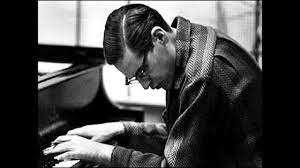
Over the past 11 years, music archivist Zev Feldman has released nine box sets of unreleased Evans recordings, most of them offering two CDs and thick, lavishly illustrated booklets with both history and commentary on the performances. Feldman calls himself the “jazz detective,” and his sleuthing has unearthed forgotten tapes that document Evans with different combos and different approaches in different settings. Some are better than others, but none is superfluous.
The latest release is Treasures, a collection of Danish radio broadcasts between 1965 and 1969. There are six solo-piano tracks, 18 piano-trio tracks and six tracks of the piano trio with symphony orchestra and six jazz horns. Evans is less interesting as a solo pianist, but these trio tracks are terrific—especially the versions of “I Should Care” and “Nardis.” Evans’ tender touch on the keys is usually warm, but then it can suddenly turn icy as it plunges into melancholy. And the symphonic arrangements by trumpeter Palle Mikkelborg lend a cinematic breadth to Evans’ chord extensions.
Contributing an insightful essay to the thick booklet for Treasures is Matthew Shipp. Shipp is often pigeonholed as an avant-garde jazz musician—and not without reason—but his appreciation for Evan’s rigorous but heartfelt approach explains why Shipp’s own playing, even at its most thunderous and freewheeling, is so full of emotion and musical memes. His experimentation always has a purpose.
That’s obvious on his new album, Live at Carrboro, a trio outing with tenor saxophonist Ivo Perelman and drummer Jeff Cosgrove. This recording is one, non-stop, 54-minute improvisation recorded live in North Carolina. It’s not noodling; it’s dialogue in the moment. Shipp and Perelman have been playing together for years, so they know each other’s language and always have something interesting to share. Cosgrove fills in the gaps with the impressionist colours of Evans’ most notable drummer, Paul Motian.


A Reader´s Perspective:by Peter Pearson
ALL POINTS FORWARD
I mentioned in my most recent column that I have tickets for a couple of live gigs over the next few weeks, that I am really looking forward to seeing
However, whilst the British Country Music scene delivers regular club nights and song-writer evenings, we don´t see a similar clutch of American songwriters visiting as frequently as they did in what I know our editor, Norman Warwick, considers the halcyon era of the seventies, eighties and into the nineties.
Norm tells me he feels incredibly lucky to have a fantastic live music scene over there on Lanzarote. However he says it tends to be classical or folk lore genre in Spanish and our beloved Americana is not big at all over there. I guess the island is a bit remote for the likes of Sarah Jarosz, who I´m going to be lucky enough to hear soon in the UK..
Given the demographics of the island, a place about the size of Rochdale, Norm says Lanzarote cannot offer a growing market for Americana artists and the logistics and costs or reaching and touring the island cannot be balanced. Even the local bands, says Norm, do not tour on Lanzarote as such, as wherever they play one night, their audience will come to them from within a circle with a diameter of about thirty miles.
Norm sent me a very complimentary e mail this week saying that he sent his search engine seeking Sarah Jarosz and had found a great cover of Bob Dylan´s Simple Twist Of Fate, and actually saying he thought she had made the song her own. There may be something inherent in Dylan songs that enables artists to do that, he suggested.
I share Norm´s admiration of Sarah´s Simple Twist Of Fate, but would also recommend her version of Ring Them Bells, a much covered Dylan song, on her Follow Me Down album. I also particularly like the Gordon Lightfoot version on his Waiting for You album and Joan Baez gave us a fine version on her superb live album Ring Them Bells.
Tim O’Brien, an artist with a body of work I really enjoy and whom I will seeing in the UK in early 2024, performs a lively version of Dylan’s Senor on his all Dylan tribute album Red on Blonde, and Dylan songs must surely be amongst the most covered of any artist.
Other cover versions deserving a mention in this despatch include two by Joe Ely (super-hero of The Flatlanders franchise), who delivered a great cover of Tom Russell´s song Gallo Del Cielo, or as Norman calls it, as do many others, that bloody chicken song ! The song seems to be something of a marmite item. Joe Ely also covered Robert Earl Keen´s The Road Goes On Forever, so well that one might think the song was actually written for him,
Given that we will be looking back at the sustained and often glorious career of The Eagles in a forthcomingg literary festival in the New Year, now might be a good time to remind readers of an excellent ac apella version of Steve Young´s eerie Seven Bridges Road, and that The Eagles also did a great job on Tom Waits´OL´55-
Those great days in the final quarter of the twentieth century were, for a travelling band of hard-core fan base centred around American singer-writers. little known in the UK being brought over by small promotion companies like Stampede, and these included
Songwriter John Stewart: Many of those hard core Americana fans thought at the time and still do, that John Stewart was America´s greatest living songwriter and yet was not massively covered. Nevertheless, Nanci Grifffith, of course, has covered some John Stewart songs such as Lost Him In The Sun, The Ghost Inside Of Me and Armstrong and Joan Baez did a great version of Strange Rivers. It was perhaps not quite a cover, but Buffy Ford, with John playing guitar beside her on Across The Milky Way on an album recorded live in Scotland, is way too good for Norm to have forgotten, but he says it was only my recent mention of these live recordings that brought the song back to mind.
Norm often tells us that his two favourite covers of John´s songs are Runaway Train (a number one country hit) and To Dance With Tiger, both by Roseanne Cash.
Given that John had previously enjoyed covers of Daydream Believer by The Monkees and Anne Murray (who claimed not to understand the song) and that The Loving Spoonful recorded Never Goin´Back, there were reasons enough to try to ascertain how many cover versions there might have been. So I set out on a quest to find out more, and discovered that it just might be that John Stewart is one of the most heavily covered of all Americana writers. Some years ago my friend Bob Elliot of Bite My Foot. org ( a JS fan site) published a list on the Bloodlines Digest of all the John Stewart song covers he could find. Fellow Bloodliners including myself were incredulous and thought it might be a wind up when we looked at it. The most unlikely one on the list was a cover of John’s Missouri Birds by Harry Belafonte.
In order to prove his credentials Bob got John Stewart to verify the list and even produced CDR’s of all the covers listed.
That list is available in the Faq section on Bob’s Bite My Foot website. It is massive.
Here are one or two of my favourites-
Kate Wolf -Some Kind of Love on her Give Yourself to Love-double live cd.
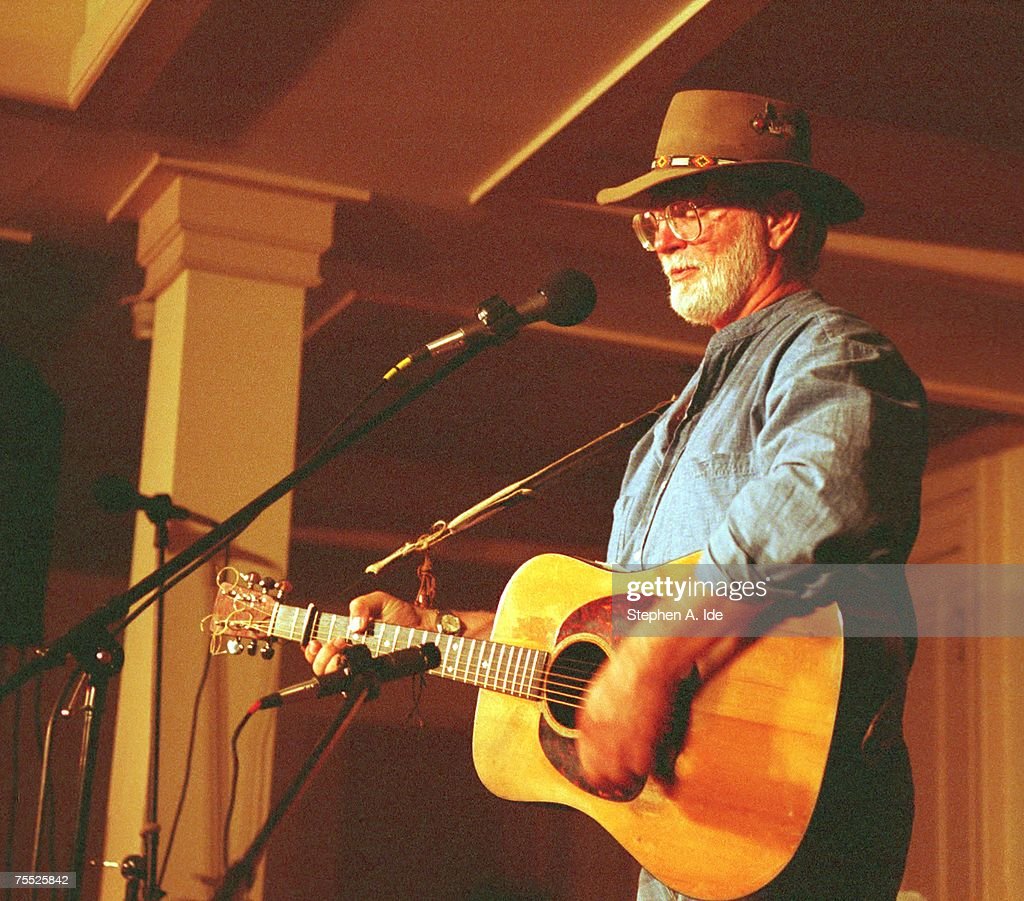
Bill Staines-Chilly Winds-Going to the West
Dave Alvin -California Bloodlines-West of the West.
Then there is the famous story John often told in concert when introducing July Your a Woman. Pat Boone called Me on the phone! -Jesus Pat Boone-. He said he wanted to cover July but was not comfortable singing -and I i have not been known as the Saint of San Joaquin and i’d just as soon right now pull on over to the side of the road and show you what I mean. This to a female hitchhiker he was giving a lift to.Pat wanted to change the lyric to show I’m not so mean. John says how do you that -show me your money?
So, it was something of a surprise when John Stewart himself covered Paul Simon´s song, Boy In The Bubble, off the Graceland album in a pretty straight rock style.

Songwriter Paul Simon, has been another heavily covered artistever since his days on the English folk scene of the sixties. Many fans of his music will also know of the Emmylou Harris version of The Boxer. I know Norm certainly loves her version but me Gretchen Peters (left) version of American Tune on her live Trio album´is one of my favourite covers of a Paul Simon song.
Songwriter Kate Wolf sadly passed away before the sixties folk scene in the UK made something of a comeback and attracted Americana artists to visit. The folk revival came too late for Kate Wolf but The Nanci Griffith version, on Other Voices, of the Kate Wolf song Across The Great Divide is excellent, but although it show-cased Kate´s writing talents Nanci´s became my preferred version of that song.
Norm tells me he used to perform with a band in the first decade of the twenty first century who used to perform a fiddle led version of Green Eyes, which including Norm reading his poem On The Strings Of Kate Wolf´s Gutar..
Songwriter John Prine saw Hello In There recorded by Bette Midler. . Among other artists to cover John Prine songs were Amos Lee who delivered an intriguing version of Speed Of The Sound Of Loneliness, and Bonnie Rait gave us an edgy Angel From Montgomery, whilst Dwight Yoakem took a John Prine track to a Paradise that had been taken away. George Strait echoed I Just Want To Dance With You and Johny Cash truly understood what Sam Stone was all about. Miranda Lambert surprised me with Thats´The Way The World Goes Round and The Zac Brown Band recorded a faithful rendition of Prine´s All The Best. Again, though, I think it was Nanci Griffith who so enhanced a John Prine song that it became my stand out recording when she covered Speed Ofg The Sound OfLoneliness.
Songwriter Guy Clark yet another well-covered American writer had his song A Nickel For The Fiddler recorded by The Everly Bothers, in 1972, the same year in which Townes Van Zandt covered Clark´s Don´t Let The Sunshine Fool You. Eight years later Rodney Crowell recorded Heartbroke, written by Guy. Then in 1985 VinceGill recorded OklahomaBorderline, the writers of which were Clark, Crowell and GIll collaboration. A Guy Clark / Richard Leigh co write produced All Through Throwing Good Love After Bad, which was recorded by Tammy Wynette as a closing album track and also was recorded on an album by Guy himself. Even as late in his career as 2012 Guy teamed up with Chris and Morgane Stapleton to pen Talk Is Cheap, recorded by Alan Jackson in the same year. The late Guy Clark covered tracks by his own part time collaborator Verlon Thompson as well as his closest buddy Townes Van Zandt but my favourite Guy Clark cover is his version of Jimmie Rodgers In The Jailhouse Now.´
Guy Clark- I just can’t think of any cover version of his songs that I prefer to his original. Jerry Jeff does a few covers of Guy’s songs that I like but do not prefer to the original
In truth, I just can’t think of any cover version of Guy Clark songs that I prefer to his master-craftsman original. Jerry Jeff Walker does a few covers of Guy’s songs that I like but do not prefer to the original
I have spoken here of titles all well known to a niche market of fans in the UK with most of those songs being covered by small circle of friends. However, if any readers of Sidetracks And Detours have any thoughts of deletions or additons to these lists, please write to sidetracks & detours at
Sidetracks & Detours
recommend
Songwriters, Songs and Singers
PASS IT ON playlist 13
collated by Pearson & Warwick

songwriter song covering artist
Bobf Dylan Simple Twist Of Fate Sarah Jarosz
Ring Them Bells Joan Baez
Ring The Bells Sarah Jarosz
Ring Them Bells Gordon Lightfoot
Senor Tim O´Brien
Tome Russell Gallo Del Cielo Joe Ely
Robert Earl Keen The Road Goes On Forever Joe Ely
Steve Young Seven Bridges Rad The Eagles
Tom Wairs Ól´ 55 The Eagles
John Stewart Lost Him In The Sun Nanci Griffith
The Ghost Inside Of Me Nanci Griffith
Armstrong Nanci Griffith
Strange Rivers Joan Baez
Across The Miky Way Buffy Ford
Dance With The Tiger Roseanne Cash
Runaway Train Roseanne Cash
Daydream Beleiver The Monkees
Daydream Believer Anne Murray
Never Goin´ Back the Lovin´ Spoonful
Mi8ssouri Birds Harry Belafonte
Some Kind Of Love Kate Wolf
Chilly Winds Bill Staines
California Bloodlines Dave Alvin
July You´re A Woman Pat Boone
Paul Simon Boy In The Bubble Stewart & Darwin´s Army
The Boxer Emmylou Harris
An American Tune Gretchen Peters
Kate Wolf Across The Great Divide Nanci Griffith
John Prine Hello In Theew Bette Middler
Speed of the Sound Of Loneliness Amos Lee
Angel From Montgomery Bonnie Rait
Paradise Dwight Yoakem
I Just Want To Dance With You George Straitt
Sam Stone Johnny Cashç
That´s The Way The World Goes Round Miranda Lambert
All The Best Zac Brown Ban
Speed Of The Sound Of Loneliness Nanci Griffith
Guy Clark A Nickel For The Fiddler The Everly Bros
Don´t Let The Sunshine Fool You Townes V Zandt
Oklahoma Borderline Vince Gill
Good Love After bad Tammy Wynette
Talk Is Cheap Alan Jackson


Island Insights
a unique musical production
at Jameos Del Agua, Lanzarote, July 2023
featuring actor John Malkovich
THE INFERNAL COMEDY
review by Norman Warwick
It was the year 2002 when Carmensa de la Hoz directed Los Aljibes de Tahíche and a national film exhibition was going to be held in the facilities of the Lanzarote centre when her phone rang and it was John Malkovich calling.
At that moment Carmensa was surprised by the call and a few days later she was with the actor on the island, along with more companions, enjoying Lanzarote and remembers still what their reaction was when they arrived at the Jameos del Agua for the first time. “When we walked in he said, ‘But what is this?’ He marveled.
That day Malkovich was captivated by Lanzarote and the Jameos Auditorium
And this week with the arrival of the play “The Infernal Comedy”, the American actor returned to the island 20 years later to fulfill one of his dreams. “He wrote to me and told me he was finally coming´.
De la Hoz recalls some anecdote from two decades ago on his first visit from which a beautiful friendship emerged that has lasted over time.
It is clear that they will see each other again either in Lanzarote, in the USA, in London or where they join their respective commitments. Despite the huge career of the actor, Malkovich was very excited to act in Lanzarote and now at 69 years old he has already fulfilled his modest dream.
The Infernal Comedy is part of the Canarias Extension of the Veranos del Taoro Festival and is supported by a dozen or so various institutions and over 20 major sponsors listed at the web site, all noted and thanked at https://www.veranosdeltaoro.com/
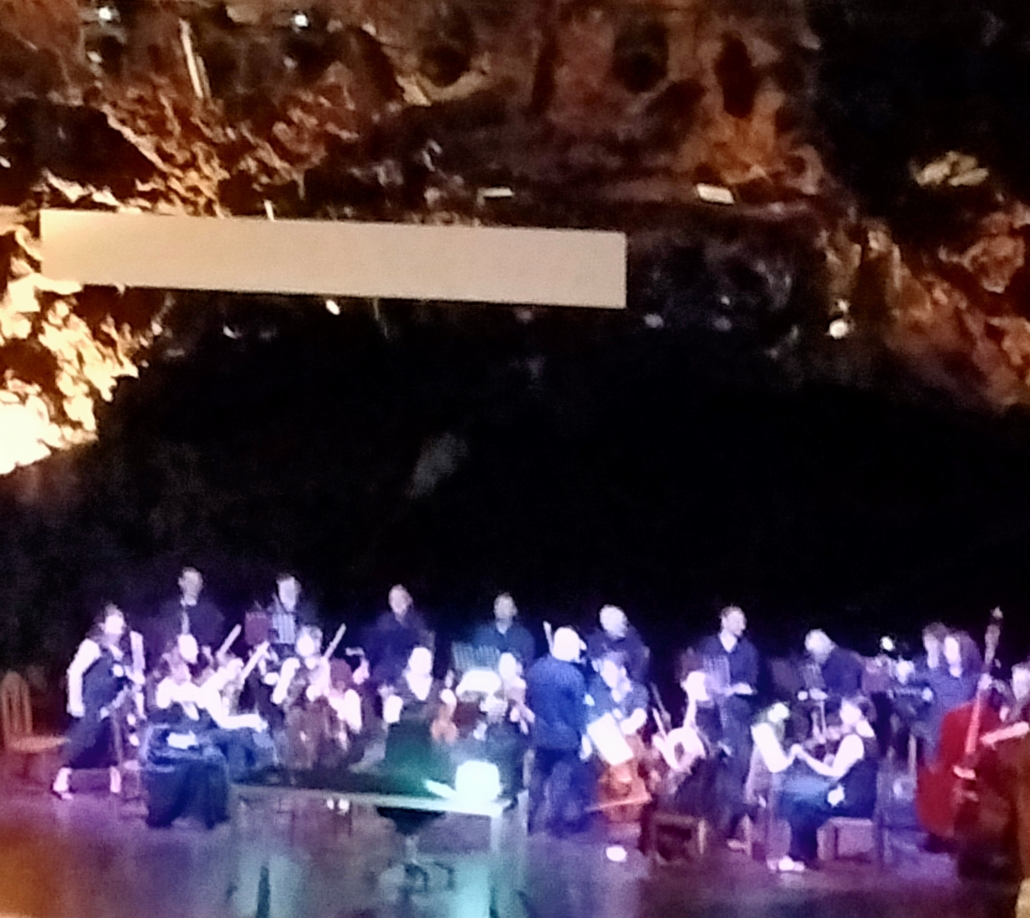
My wife, Dee, and I purchased two of the last few seats shown as being still available at the ticket-vending web site at 85 euros each, even though we attended in a journalistic capacity rather than ´merely´ as fans, and that pejorative of merely was in some ways used provocatively by the soliloquist in his rambling and rants. So this was the renowned actor and filmmaker we are accustomed to Being John Malkovich immersing us in the life of serial killer Jack Unterweger. This serial-killer had been give a life sentence for strangling a young woman in 1974 but was later released, and a continuation of his crimes
Once the oprchestra had assembled (right) he performance began with opening music played live on stage by more than twenty musicians from the accompanying Orchester Wiener Akademic and sopranos Susanne Langbein and Chen Reiss.
Whilst the music and vocals were sublimely delivered at various points of the play to illuminate the incidents that the central character of Malkovich or Unterweger was describing, to amplify various academic answers he was giving to his own questions, the body count kept climbing, and the sopranos each seemed to suffer multiple deaths, with scenes of the them being seduced, as are moths to the flame, by the man they wished to understand !
Let me be honest here, and say that this was not an easy read or an easy watch. It was confusing, chaotic and sometimes downright contradictory, just as both the actor, being John Malkovich and the auto-biographer being a murderer wanted it to be.
I have been interviewing major artists for decades now, after studying Literary Theory at The University Of Leeds as a ´mature´ student. I´m sorry, I don´t mean to interject my biographical details into a review about one man being two who is trying to sort fact from faction in each of their autobiographies. I grew up on stories put about by a young Robert Zimmerman that created the character of Bob Dylan and I have heard songs allegedly being sung by redneck racists who are actually middle of the rod country music.
All that academia was pulled from under my feet though in this beautiful, incredible and packed to the rock-face theatre that is the underground cave at Jameos Del Agua or as Malkovoch, or was it Uterweger, called the only s++t theatre my s++tty promotion team could get me into. Whoever this man was on stage, pulling the strings of the orchestra and creating a song selection to tell his story led us on a not-so merry dance
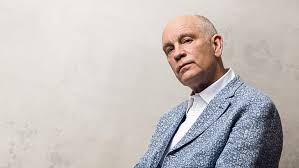
photo john malcovich Clues to the truth, the whole truth and nothing but the truth, were difficult to pick up, though one half of the man portraying the two men on stage did point us towards tonight´s title, The Infernal Comedy, one of them said, or maybe we were told by the producers in the programme notes, is a unique musical production featuring actor John Malkovich portraying a serial killer.
Directed by Michael Stturminger, this production combines Unterweger’s narration with music from composers such as Vivaldi, Haydn, Mozart, Beethoven, Boccherini, Weber, and Gluck. An experience that transitions from touches of humour to dark drama.
The adjective we are used to seeing in front of the word comedy, in this context is Divine, which would seem a directly opposite description. The Divine Comedy was written by Dante Alighieri. more than 700 years ago and It describes one man’s journey through the afterlife, telling a timeless story about love, faith, and justice. Dante has inspired everyone from French sculptor Auguste Rodin to British draftsman William Blake.
All we learn from this comparison, however, is that seven centuries later someboy has slightly tweaked a title and writer a (life) story that follows the same twisted trails. Whether that was done by Malkovich or Unterweger, we are still not sure. Never mind about that, though, for surely everyone in the theatre was wondering, as I was, whether this tile was applied to the Malkovich / Unterweger collaboration before or after the completion of the (auto) biography. No, no, of course,…I´m sorry, there is no evidence that The Infernal Comedy is the result of any kind of collaboration !
Unterweger is at pains to convince us that The Infernal Comedy is the title of his autobiography, but if that is the case, what is Malkovich even doing here?
As soon as I process that thought I begin to wonder why a man, a serial, killer who has avoided life-long custoidy, would want to set himself up for further judgement. Will he suffer for his crimes all over again or will he be subject to what Roland Barth
“The Death of the Author” (French: La mort de l’auteur) is a 1967 essay by the French literary critic and theorist Roland Barthes (1915–1980). Barthes’ essay argues against traditional literary criticism‘s practice of relying on the intentions and biography of an author to definitively explain the “ultimate meaning” of a text. Instead, the essay emphasizes the primacy of each individual reader’s interpretation of the work over any “definitive” meaning intended by the author, a process in which subtle or unnoticed characteristics may be drawn out for new insight. The essay’s first English-language publication was in the American journal Aspen, no. 5–6 in 1967; the French debut was in the magazine Manteia, no. 5 (1968). The essay later appeared in an anthology of Barthes’s essays, Image-Music-Text (1977), a book that also included his “From Work to Text”.
In his essay, Barthes argues against the method of reading and criticism that relies on aspects of an author’s identity to distill meaning from the author’s work. In this type of criticism against which he argues, the experiences and biases of the author serve as a definitive “explanation” of the text. For Barthes, however, this method of reading may be apparently tidy and convenient but is actually sloppy and flawed: “To give a text an author” and assign a single, corresponding interpretation to it “is to impose a limit on that text.”
Readers must thus, according to Barthes, separate a literary work from its creator in order to liberate the text from interpretive tyranny (a notion similar to Erich Auerbach‘s discussion of narrative tyranny in biblical parables).[1] Each piece of writing contains multiple layers and meanings. In a well-known passage, Barthes draws an analogy between text and textiles, declaring that a “text is a tissue [or fabric] of quotations,” drawn from “innumerable centers of culture,” rather than from one, individual experience. The essential meaning of a work depends on the impressions of the reader, rather than the “passions” or “tastes” of the writer; “a text’s unity lies not in its origins,” or its creator, “but in its destination,” or its audience.
No longer the focus of creative influence, the author is merely a “scriptor” (a word Barthes uses expressively to disrupt the traditional continuity of power between the terms “author” and “authority”). The scriptor exists to produce but not to explain the work and “is born simultaneously with the text, is in no way equipped with a being preceding or exceeding the writing, [and] is not the subject with the book as predicate.” Every work is “eternally written here and now,” with each re-reading, because the “origin” of meaning lies exclusively in “language itself” and its impressions on the reader.
Barthes notes that the traditional critical approach to literature raises a thorny problem: how can we detect precisely what the writer intended? His answer is that we cannot. He introduces this notion of intention in the epigraph to the essay, taken from Honoré de Balzac‘s story Sarrasine in which a male protagonist mistakes a castrato for a woman and falls in love with him. When, in the passage, the character dotes over his perceived womanliness, Barthes challenges his own readers to determine who is speaking, and about what. “Is it Balzac the author professing ‘literary’ ideas on femininity? Is it universal wisdom? Romantic psychology? … We can never know.” Writing, “the destruction of every voice,” defies adherence to a single interpretation or perspective. (Barthes returned to Sarrasine in his book S/Z, where he gave the story a rigorous close reading.)
Acknowledging the presence of this idea (or variations of it) in the works of previous writers, Barthes cited in his essay the poet Stéphane Mallarmé, who said that “it is language which speaks.” He also recognized Marcel Proust as being “concerned with the task of inexorably blurring … the relation between the writer and his characters”; the Surrealist movement for employing the practice of “automatic writing” to express “what the head itself is unaware of”; and the field of linguistics as a discipline for “showing that the whole of enunciation is an empty process.” Barthes’s articulation of the death of the author is a radical and drastic recognition of this severing of authority and authorship. Instead of discovering a “single ‘theological’ meaning (the ‘message’ of the Author-God),” readers of a text discover that writing, in reality, constitutes “a multi-dimensional space,” which cannot be “deciphered,” only “disentangled.”
“Refusing to assign a ‘secret’, an ultimate meaning” to text “liberates what may be called an anti-theological activity, an activity that is truly revolutionary since to refuse meaning is, in the end, to refuse God and his hypostases—reason, science, law.”
I wouldn´t have remembered all this from my UNi days, but John Malkovich or his partner in crfime made me do so. I swear it was all there in this play tonight. It might have been delivered in a darkly comedic but has my professors delivered ´Bartthes´Death Of Author theory in the manner of Malkovich I´d have earned a ´first´!
Having only heard of the performance a couple of days earlier, I had not been able arrange any kind of interview. Nevertheless, things were put in perspective by our favourite waitress at Robbie and Sany´s excellent Skyline Restaurant in Playa Blanca, who had seen a notice about the play, and certain that it was something in which we´d be interested, gave us performance dates and times.
At 23 years old she was aware of Malkovich and some of his film work and thought he was an artist of great stature and how proud Lanzarote should be to have been chosen as one of the two Canary Islands on which the play was to be premierred. This fast talking young lady can tie me in knots every time she speaks with me and it might have been fascinating to hear her views and her questioning of the ´meaning´ of the play.
Had I have been given the opportunity to interview the author, actor or character I would have gone along with my buddies, who are known at secondary schools where I taught in the UK, as ´the five bums at the bar,´ or Messrs. Who, What, When, Where, Why. I have always found their staccato style of interogation to be quite revealing.
So, who is John Malkovith ?
Well there was no point in my trying to ask him from our seats in the Gods, and anyway I´d have never got a word in edgeways.
According to mini biography written by <tony.fontana@spacebbs.com> John Gavin Malkovich was born in Christopher, Illinois, to Joe Anne (Choicer), who owned a local newspaper, and Daniel Leon Malkovich, a state conservation director. His paternal grandparents were Croatian. In 1976, Malkovich joined Chicago’s Steppenwolf Theatre, newly founded by his friend Gary Sense. After that, revival of “Death of a Salesman”, which would earn him an Emmy when it was made into a made-for-TV movie the next year. His big-screen debut would be as the blind lodger in Places in the Heart (1984), which earned him an Academy Award Nomination for best supporting actor. Other films would follow, including The Killing Fields (1984) and The Glass Menagerie (1987), but he would be well remembered as Vicomte de Valmont in Dangerous Liaisons (1988). Playing against Michelle Pfeiffer and Glenn Close in a costume picture helped raise his standing in the industry. He would be cast as the psychotic political assassin in Clint Eastwood‘s In the Line of Fire (1993), for which he would be nominated for both the Academy Award and the Golden Globe. In 1994, Malkovich would portray the sinister Kurtz in the made-for-TV movie Heart of Darkness (1993), taking the story to Africa as it was originally written. Malkovich has periodically returned to Chicago to both act and direct..
It would take seven years before Malkovich would show up in New York and win an Obie in Sam Shepard‘s play “True West”. In 1984, Malkovich would appear with Dustin Hoffman on Broadway.
So his canon of work is solid and at times spectacular. It has never been interrupted by a fifteen year jail sentence, and neither has it been affected by bad publicity of any kind. In fact as an artist he has a reputation, perhaps, of following the road less taken, and is perhaps more credit-worthy for that.
What, I wondered, was he seeking to achieve? Was he here in a text that revealed him as a misogynist, even while revelling in being a lady-killer. He was maybe hoping to sell an autobiography that was neither auto nor bio. Maybe he was looking to reveal himself as something of an intellectual pontificating on how women drag him down, the inefficiency of the agencies who promise to make him into a star.
I even wonder if he can ever stop questioning everything and everyone around him and what does he choose to reveal to the world in his autobiography,….and what does he choose to conceal,….and why and to and from whom?
To look at him we might not suspect the fires that burn inside him. He is a pretty fit guy for his age, I guess. I would imagine he could slip through a crowd and remain pretty much un-noticed as one of the world´s greatest actors or as a quiet killer.
When Malkovich sets out on tours like this, in a production like this, does he expect success or failure? Would he settle for any point in between, and if he did would we believe him ?
Where now for a production that last night was delivered in English, a rare treat for we new residents who haven´t yet learned to speak Spanish? Simultaneously, as we heard the actor´s voice we saw, via an innovation for us, the dialogue flashing up in Spanish electronic sub-titles via an overhead contraption. I´m not sure that it in any way increased our belief in whatever we were hearing, It just all added to a-more-than-slightly-disturbing Orwellian atmosphere.
Whenever the dialogue seemed to answer any of the questions we were being led to consider, that answer simply created a hole that was too quickly filled with shovels-full of more question-nurturing soil. As much as we sweated the little things, who were these women this man had murdered and what was the legalistic hiccup that had led to his release, we were left asking ourselves which of these two men we should believe,….which was flipping ridiculous when this was a one man cast !
The beautiful river of music from the orchestra had rolled and flowed and slipped over a litany of sharp lies, somehow wearing and eroding them into smoothed, but slippy stepping stones.

photo john malkovich congratulates Whenever I sat in one of these kind of literary theory debates at Uni I would feel exhausted at the end of the cut and thrust between delusion and illusion. Yet I and my fellow students would almost collapse into a sustained applause, (almost of relief) for what our lecturer had dragged us through. And it was the same here,….after almost two hours emotion and elusion, of dreaming and scheming and screaming the entire full house 600 seated audience rose wearily to their feet, almost senseless from the complexity and complicity of it all, from the sidetracks and detours we had followed all across the arts. The applause was long-sustained and carried admiration for a man who spent two hours seeking to deceive and yet who shared literary secrets with us even as he led us astray with his words.
When we all climbed out of this glorious natural cave, turned into a theatre by visionary artist Cesar Manrique, couples were talking excitedly about all the clever questions they would have asked had they been on that jury, (what jury? we were the jury !) whilst others were saying the questions we might have asked would have been rebuffed and the story would have just continued to evolve into art-breaking alibis, legends and lies.
As I heard one woman say to her companion that it must have all been based on a true story. I hoped she was right. It had been an autobiography for God´s sake,,,,,by somebody, about something.
Or, it had been John Malkovich messing so much with our heads that we might never again read a novel or a newspaper or a biography in quite same way as we had done until tonight.
And he´s an actor,….. so we can trust him, …. surely !

It had felt all through the evening that ´the murderer´ had not fully paid for his crimes. However, maybe the whole event was an example of a new literary trait that has come into being, (if you believe the newspaper columnists) over the last few years and has something to do, perhaps, with the Black Lives Matter movement. Could this murderous biography actually be all about Malkovich in the guise of a guilty narrator (the likes of which have hidden under our book covers for centuries).
Was all this merely an example of the use of Metafiction: a form of fiction that emphasizes its own narrative structure in a way that continually reminds the audience that they are reading or viewing a fictional work?
Perhaps it was all a search for where truth lies?
The laugh out loud moments were too few to add up to a comedy, the linear narrative line turned down so many cul de sacs and any sympathy the audience had for the two characters, sorry, for the one solo character was withheld because every direct and understandable sentence (except the life sentence, perhaps) was followed by a long and winding road right back to the beginning so as to further confuse as to whether we were listening to a story of fact or fiction. We had, at times, been supping with the devil and at others walking on the side of the angels.
An incredible actor had, I think, played the part of a writer and literary theorist, and in doing so gave us a comprehensive study in literary theory and techniqe. We came out of the theatre, walking up towards the starry moonshine sky, and we were blinded by the light.
I have spoken many times on these pages about how songwriter Hugh Moffatt once said to me in an interview that ´writers must prepare what we write for light years of travel´.
This work has been thoroughly prepared and will be being discussed in centuries to come, as is Dante´s work now.
What a great evening this was with the writer, John Malcovich !
There is, however, a footnote: The Infernal Comedy: Confessions of a Serial Killer by John Malkovich has previously shown at the Brooklyn Academy of Music.
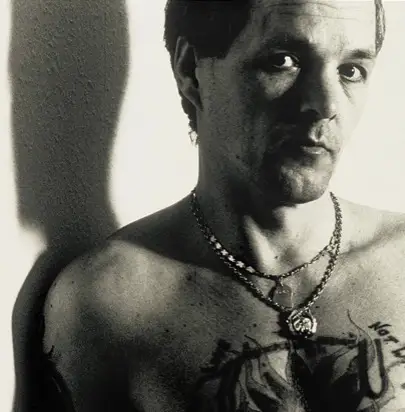
Here, Malkovich, live on Lanzarote, played a real-life Austrian man named Jack Unterweger , who started murdering prostitutes in the 1970s when Ted Bundy and Son of Sam were tabloid staples.
According to the Crime Wire web site, Jack Unterweger was a Journalist, Literary Celebrity and Serial Killer. In fact the site suggests he has become a kind of ´poster boy´ for rehabilitation.
While imprisoned, he produced a prolific portfolio of works, including a play called Purgatory, in which he meditated on the Dantesque idea that he was between Heaven and Hell, neither dead nor alive, but rather undergoing punishment in hope of redemption.
Unterweger also wrote children’s stories and in the late 1970s, the ORF state broadcasting company began airing them. He later used this platform to craft a narrative of his childhood—one in which he yearned for his absent mother, and was traumatized by the murder of his aunt, a prostitute who “was killed by her last customer.”
Unterweger gave televised readings of his work from prison and slowly built a following in Vienna’s literary circles, where the idea of a murderer rehabilitating himself through art struck a chord among the nation’s intellectuals.
Unterweger’s boyish good looks and charm further endeared him to his fans; before long, Unterweger became a celebrity. After he served the minimum 15 years of his sentence, there was a fully fledged campaign to get Unterweger paroled. Literature had cleansed Unterweger’s violent instincts, Vienna’s intellectuals and political ideologues argued.
With the goal of a new re-socialization program in the justice system and the dream of a “prisonless society,” Jack Unterweger became the poster boy for criminal rehabilitation. Jack Unterweger was not a killer—he was an artist now.
Jack walked out of prison on May 23rd, 1990 at the age of 39. Shortly thereafter, Unterweger gave his first reading as a free man. Always one for flair and grandiose style, Unterweger’s newfound celebrity curried favoor with the nation’s rebellious art scene.
For a magazine photo spread, he posed in a cobwebbed attic in only blue jeans, his surprisingly muscled and tattooed chest and legs bare. There happened to be a long rope lying about, which Unterweger fashioned into a noose and posed as both the hangman and the executed.
The next year, eerily contemporaneous with the release of the horror film The Silence of the Lambs, three prostitutes from Vienna’s Red Light District were found brutally murdered; a year later, another was found in the nearby town of Graz.
Just as a new kind of serial killer blew up the cinema—the brilliantly sadistic Hannibal Lecter—Vienna received its first real one. It was as though Hannibal had transmogrified from the screen to reality. Terror seized the streets of Vienna.
As the police searched for the killer, Unterweger got involved, writing an article about the murders in which he advocated for the safety of sex workers in the red-light district and criticized the sensationalist angle most reporters took.
He accused middle-class readers of “greedy voyeurism” and said that hysteria over the crimes was preventing investigators from finding the murderer, a phenomenon that closely paralleled the Black Dahlia investigation in Los Angeles decades earlier.
“We should be glad there is a red-light district,” Unterweger said. “The dead [women] in the Vienna Woods are another argument for why society should do more to provide security for prostitutes.”
Unterweger took a keen interest in the murders and planned to report on them extensively. He peppered the police chief with questions, though he couldn’t divulge critical details. Jack wanted to know what they knew. What the police could disclose to the public was that there were seven victims—all sex workers, all strangled to death.
What the police couldn’t disclose to the public—details which had to be safeguarded because only the killer would know them—were far more disturbing.
The killer’s weapon of choice each time was the victim’s bra. Because of its elastic bands, a bra is by itself already a sufficient tourniquet by which to strangle someone. But the killer made a cut in a shoulder strap and reconfigured the bands and straps in such a way as to be able to use three ligatures and “tie the nooses at maximum tension.”
Such constriction of the carotid arteries, which ultimately compressed the victim’s neck by several inches, allowed the killer to methodically control the pace of strangulation and draw out the torture.
Unterweger lived at the infamous Cecil Hotel while he stalked victims in downtown Los Angeles, and the above is recorded in a brief biography collaborated by Jarad Salas and Jake Anderson.
.However confused and confusing this review might be, I feel sure that this level of confusion is what Malkovich sought to create. That he succeeded so gloriously and completely is what made the event so dizzying and mystifying. Had I stopped every exiting viewer on their way out to describe in one word what we had just witnessed, I feel I might have heard 600 different words offered.
My own word? Genius !

We return to our Monday to Friday daily excursions down Sidetracks And Detours to gather more arts pieces for you. We head out to Middle Earth on Monday 14th August to hear everybody Talking Tolkien, before we go Skip To My Lou to find out what on Middle Earth that phrase means. On Wednesday we will hear Patt Smith speak, and the following day we will chase a man upon his pony on a boat but will ensure we home in time on Friday to continue building our bigger bookshelf, this time to ensure we have room for Well Of Souls. The next PASS IT ON supplment will be in you e mail box on Sunday 20th August, carrying our review of the the new film Oppeniemer.
So, well see you round the corner and wsih you happy trails until then.



Leave a Reply
Want to join the discussion?Feel free to contribute!